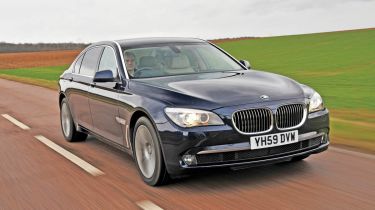BMW 730Ld SE
After the controversial styling of previous models, the latest 7-Series is... well, disappointingly bland
When it comes to luxury car heritage, BMW can’t quite match its rivals here. The first 7-Series didn’t appear until 1977 – a full nine years after Jaguar debuted the XJ badge on its flagship four-door.
Despite its late arrival, the blue propeller model has always tried to be the life and soul of the premium car market. With its engaging driving dynamics and hi-tech engineering, the 7-Series traditionally appealed to drivers as much as passengers. Not that you’d know by looking at it...
After the controversial styling of its predecessor, the latest version is bland. Launched last year, the biggest BMW of all takes its conservative design cues from the 3 and 5-Series. As a result, it lacks the visual impact and road presence of the stylish XJ or imposing Mercedes. It’s a similar story when you climb aboard. The dashboard design, instruments and switchgear follow the same template as the smaller models in BMW’s range – although that means the layout is excellent and all the major controls perfectly sited.
The quality is superb, too, and the 7-Series matches the beautifully built S-Class for fit and finish. On the other hand, the standard leather trim looks and feels artificial alongside the soft hide covering the XJ’s seats.
Used - available now

2023 Honda
Jazz
37,393 milesAutomaticPetrol1.5L
Cash £16,000
2014 Audi
A5
78,540 milesManualDiesel2.0L
Cash £8,350
2022 Abarth
595
54,000 milesManualPetrol1.4L
Cash £8,500
2016 Tesla
Model S
78,000 milesAutomaticElectric
Cash £18,999Passengers riding in the back of the BMW get plenty of space, though. In long-wheelbase form, the 7 offers 890mm of legroom – a full 40mm more than the Merc.
Neat features include angled footrests and the optional rear seat entertainment set-up. The latter is pricey, at £2,280, but it comprises a separate iDrive controller for rear seat occupants and two large TV screens in the front seatbacks. Other desirable extras include the £3,415 Executive Plus package. This adds soft-close doors, electric sunblinds for the side windows, 19-inch alloy wheels plus seat heating for front and rear occupants.
Steer clear of the options list, however, and the 7-Series appears spartan when compared with the well equipped Jaguar. BMW owners won’t feel short-changed on pace. Under the long bonnet of the 730d is the smooth and punchy 242bhp 3.0-litre six-cylinder diesel. Although it’s the least powerful of our trio, it recorded a 0-60mph time of 6.7 seconds – equalling the Mercedes and only one-tenth behind the significantly lighter Jag.
In the real world, what impresses most is the BMW’s muscular mid-range pace, while its six-speed automatic gearbox responds promptly to throttle inputs. Turn into a corner and it’s clear the 7-Series shares the sporting DNA of its smaller brothers. Standard equipment includes Dynamic Drive Control, which allows drivers to choose from four separate steering, damper and throttle settings. Comfort mode delivers a reasonably supple ride, while Sport+ sharpens the 730d’s responses.
Our test car was also fitted with the firm’s £1,195 four-wheel steering system.
The clever set-up is unnerving at first, as you often need less lock than you expect to negotiate corners. But it certainly increases agility through tight bends and stability at higher speeds.
Sadly, even this innovation can’t compensate for the BMWs major failing: a lack of charisma.
Details
Chart position: 3
WHY: German brands dominate luxury market, and the latest version of the BMW is a hugely capable choice.







